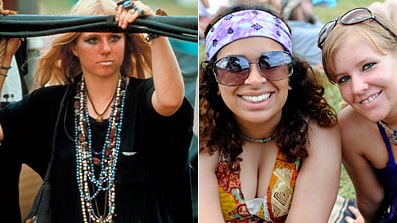Counterculture fashion in the 1960s was actually counter to something. At Woodstock, when there was a war going on in Vietnam, ironically wrapping yourself in an American flag or wearing a military jacket wasn’t just a fashion statement, it was a political statement. That there are wars happening in Iraq and Afghanistan is not something you would glean from the average outdoor music festival concert-goers today, though they might still wear tie-dye and cover themselves in mud—this time for the benefit of photographers and news cameras, imagining that they, too, are a part of history. Except that they’re not. These nouveau bohemians are just buying overpriced beer and walking around looking like advertisements for American Apparel. They’re not wearing denim as a way of dropping out of society.
VIEW OUR GALLERY OF FESTIVAL FASHION, THEN AND NOW

When we celebrated the 25th anniversary of Woodstock in 1994, it felt like an important time to commemorate the era, because the '60s were being freshly revived at the time, in the form of headbands, clogs, bell bottoms, a baby boomer president and Val Kilmer as Jim Morrison. Outdoor festivals like Lollapalooza were just taking off, too, giving a new generation of teenyboppers a chance to flaunt their alternative, bohemian lifestyles. Now we’re celebrating the 40th anniversary, but it feels a little less significant this year. Maybe because '60s counterculture—the music, the fashion—has been played out. What felt like a new discovery in the '90s is beginning to look as weathered as Rachel Zoe. While there’s still a handful of girls running around in their Urban Outfitters-issued headbands and mukluks, most young designers are “more likely to wax nostalgic about Desperately Seeking Susan and '90s grunge,” acknowledges WWD in the introduction to a Woodstock anniversary-themed spread of sketches by designers like Alexander Wang. They looked like the results of a forced assignment you’d find in fashion school. Wang’s sketch, of a nude strategically covered by leaves, at least got the most important fact about '60s counterculture “fashion”—it was mostly anti-fashion: Clothing optional. Let’s see if Urban Outfitters can figure out a way to sell that.
ADVERTISEMENT
Renata Espinosa is the New York editor of Fashion Wire Daily. She is also the co-founder of impressionistic fashion and art blog TheNuNu and a sometimes backup dancer for "The Anna Copa Cabanna Show."





